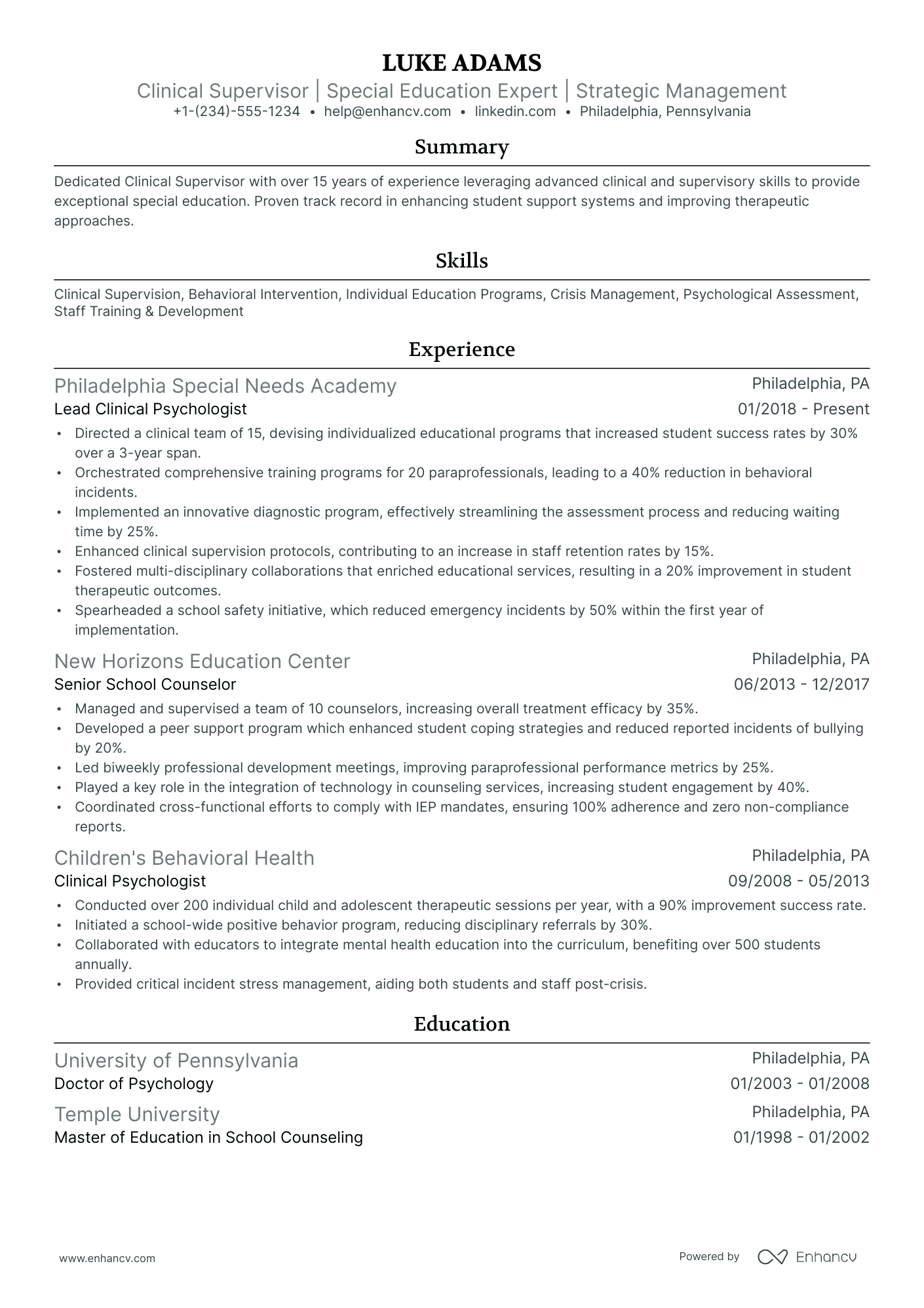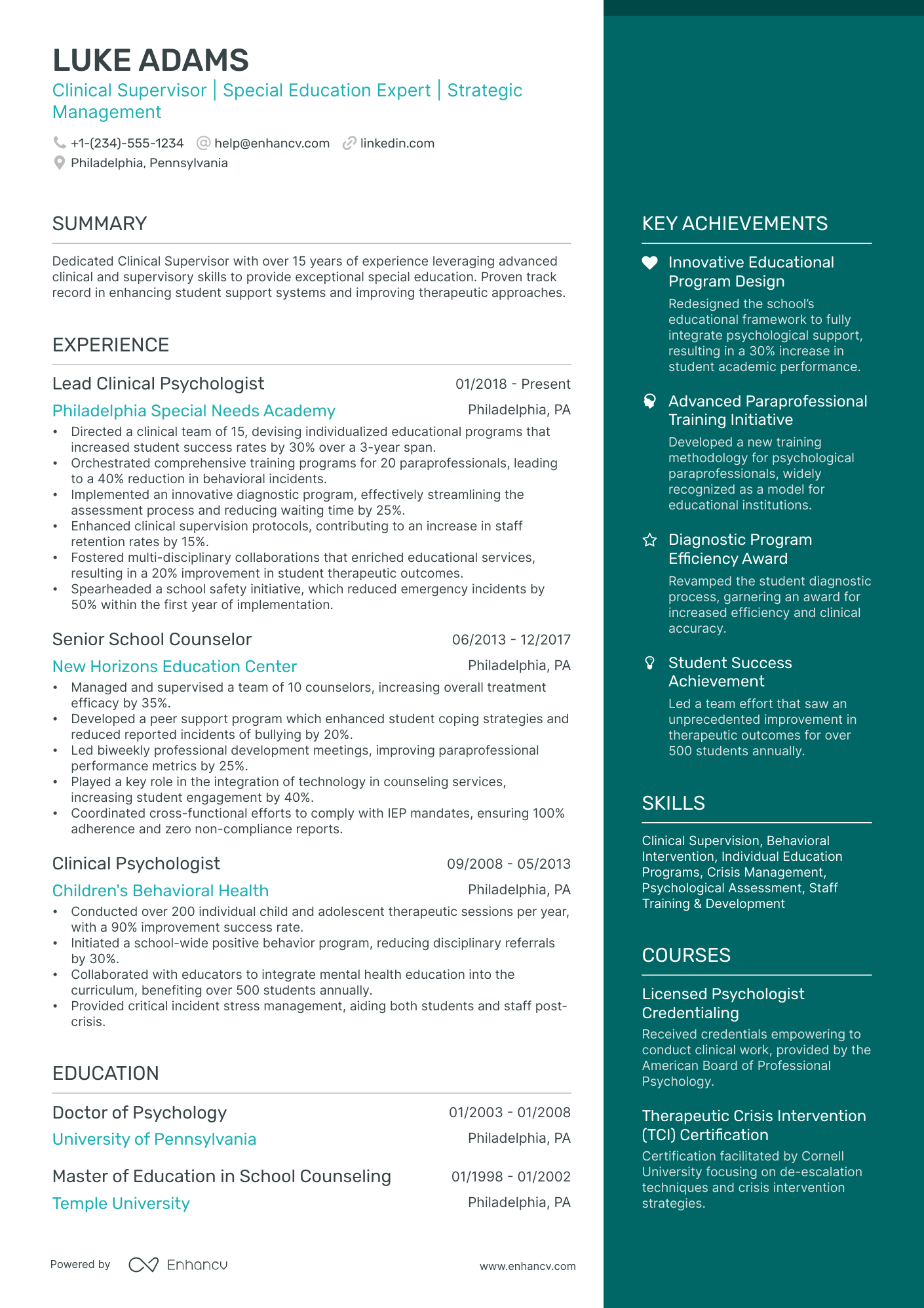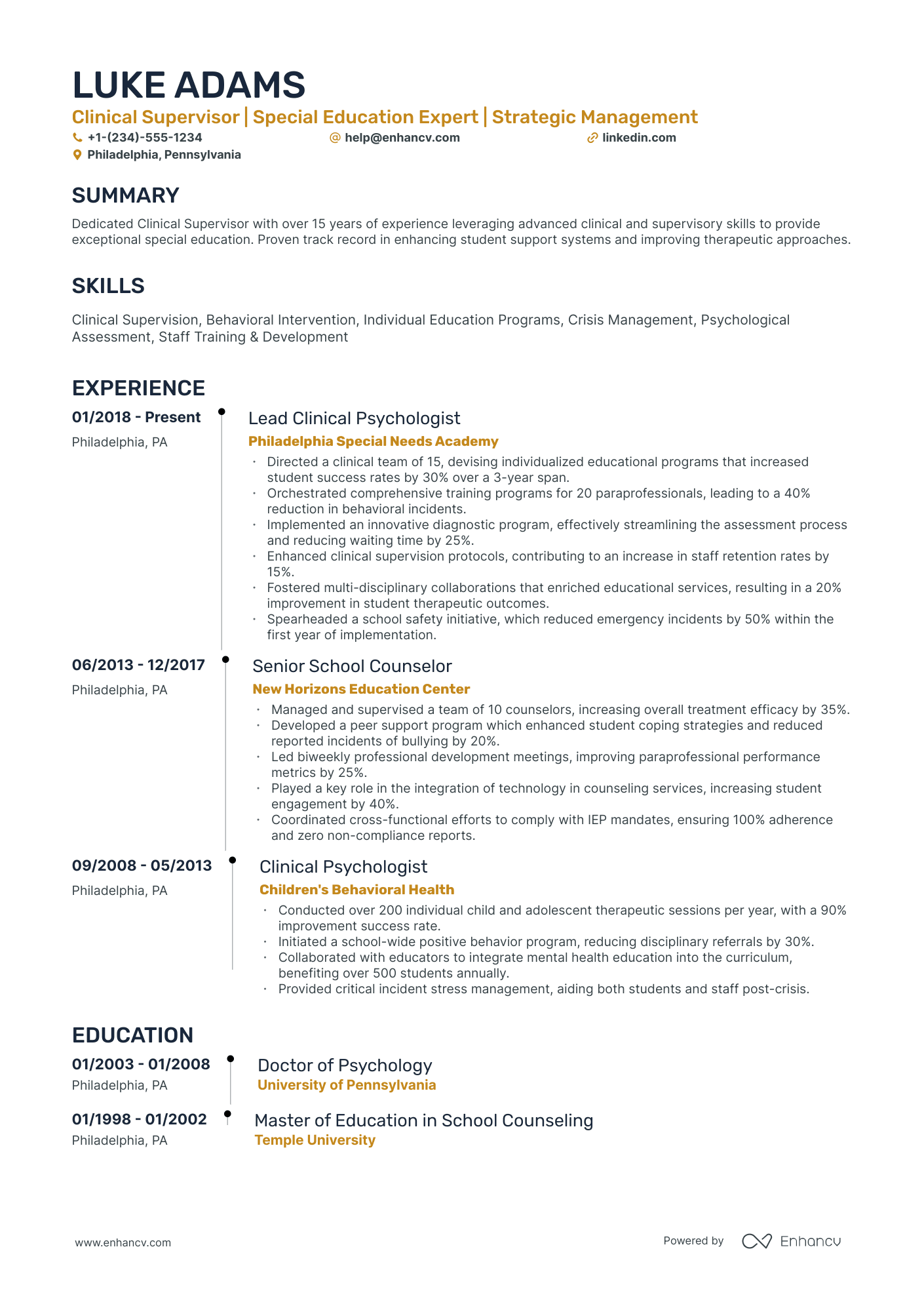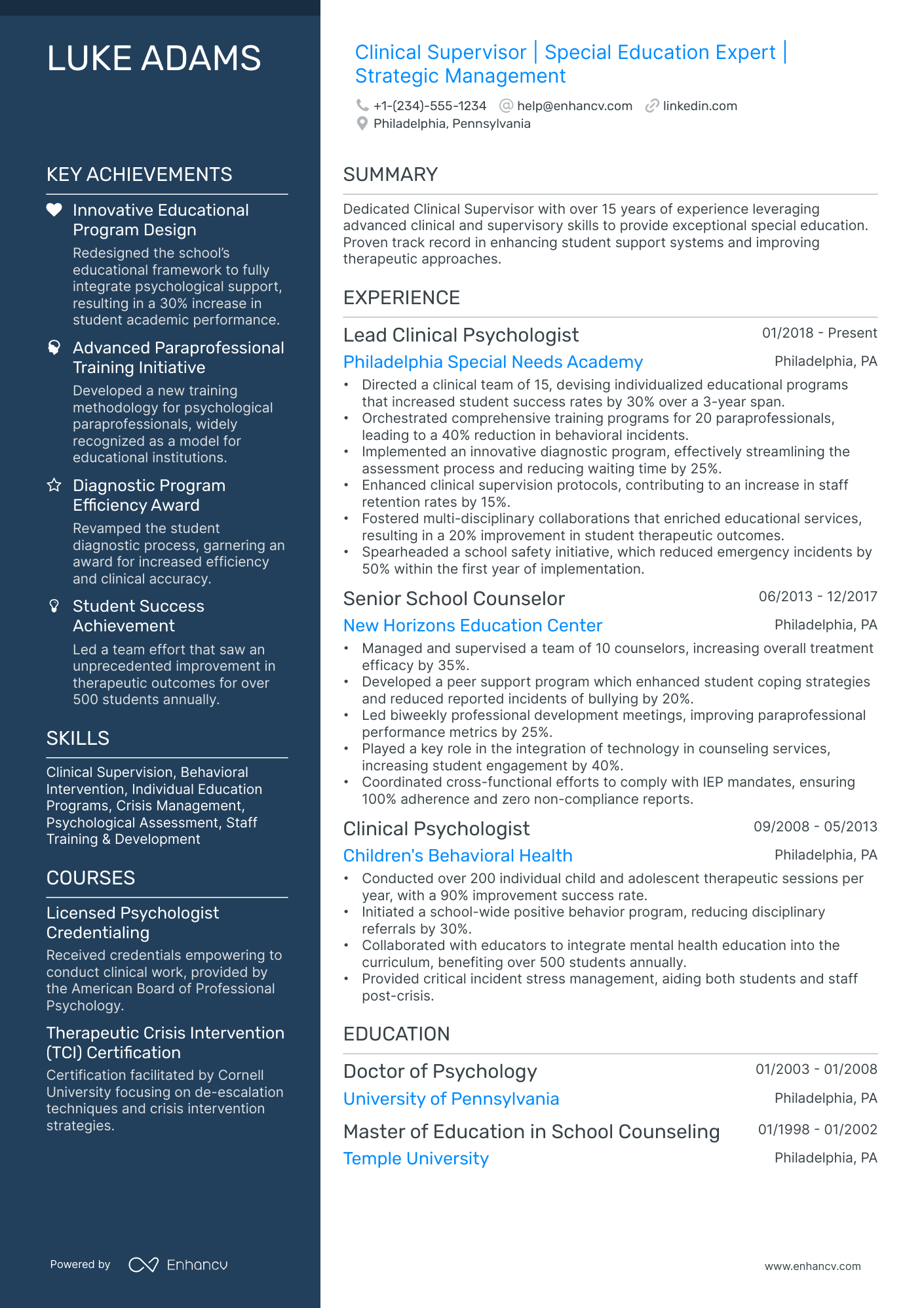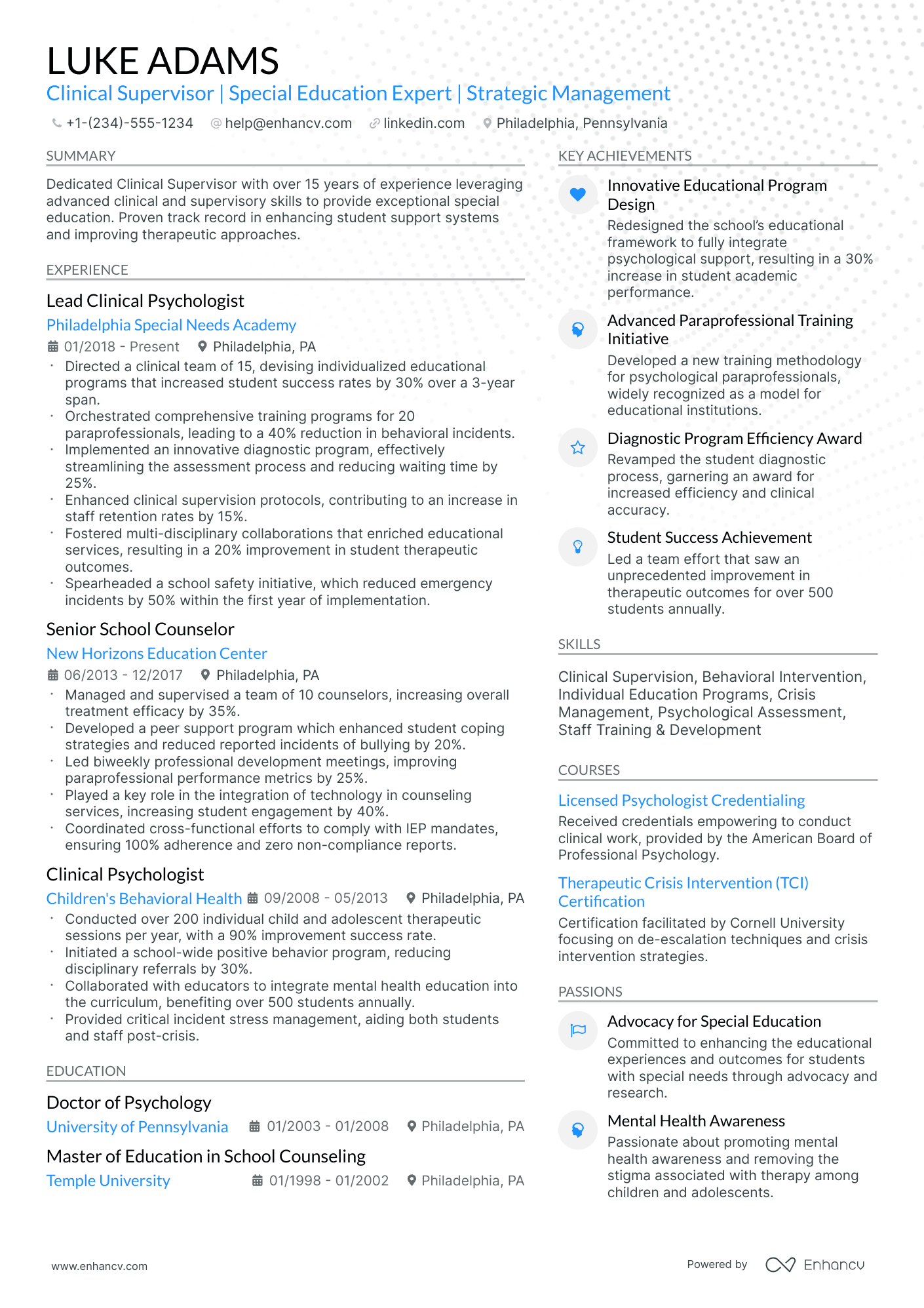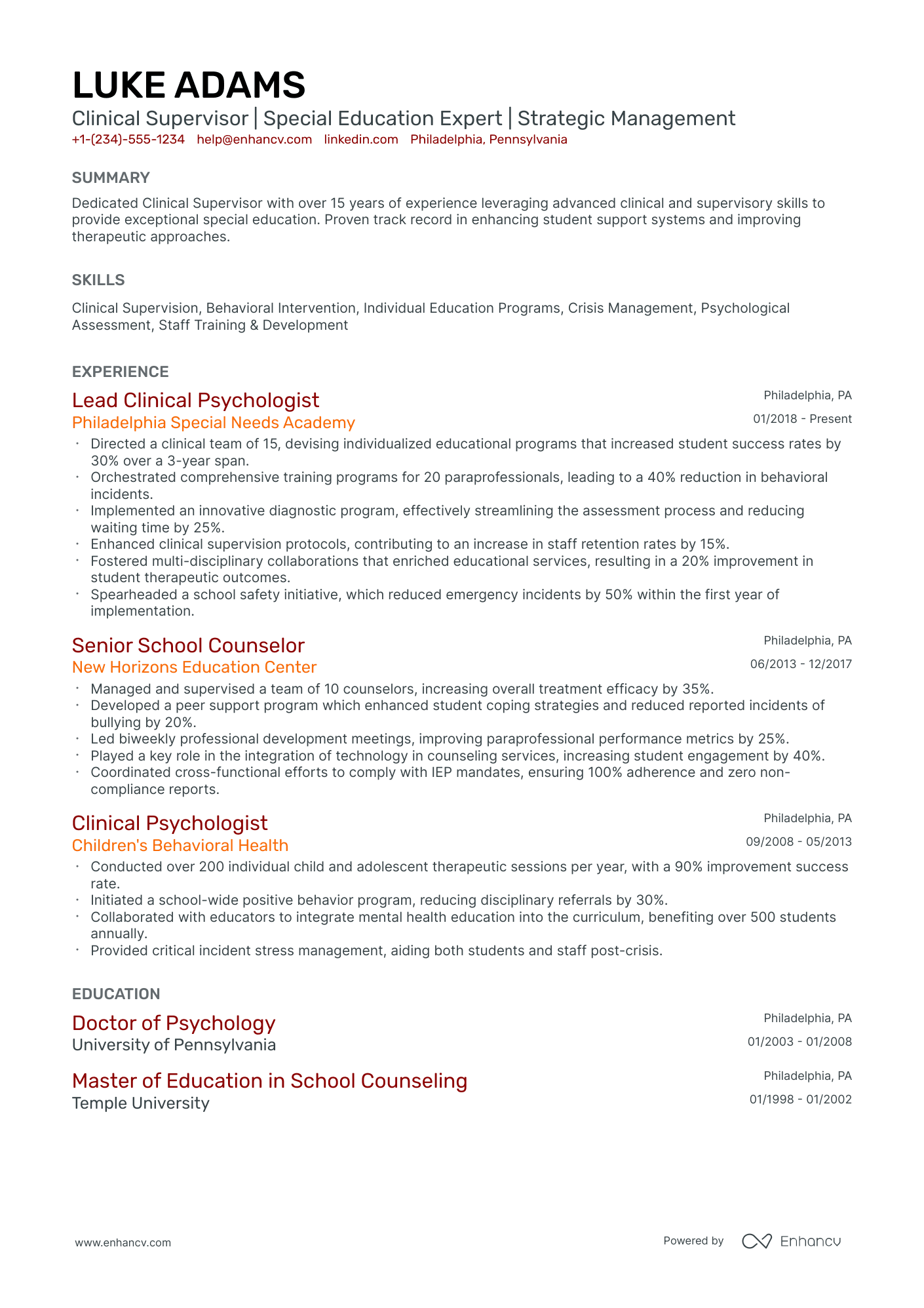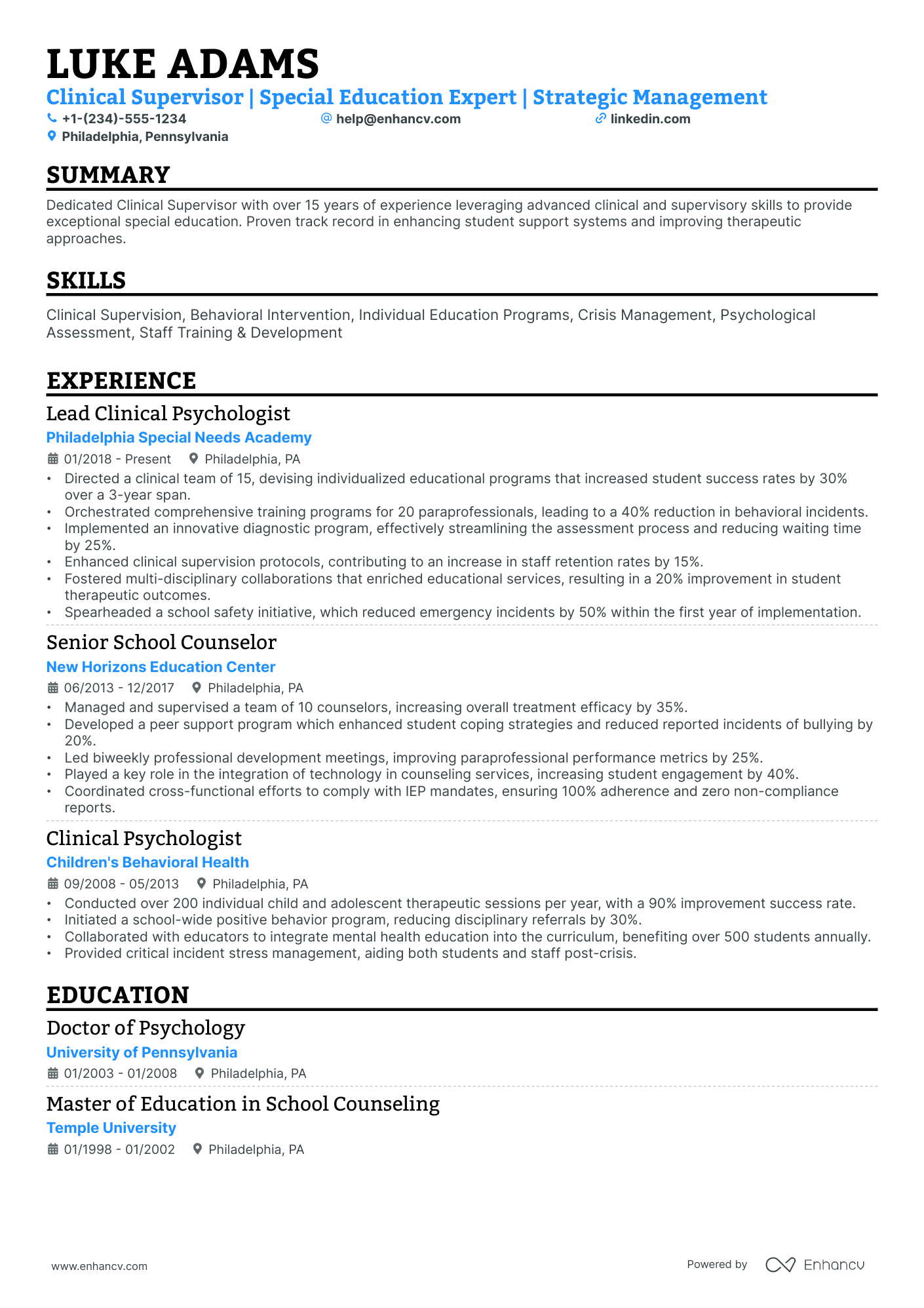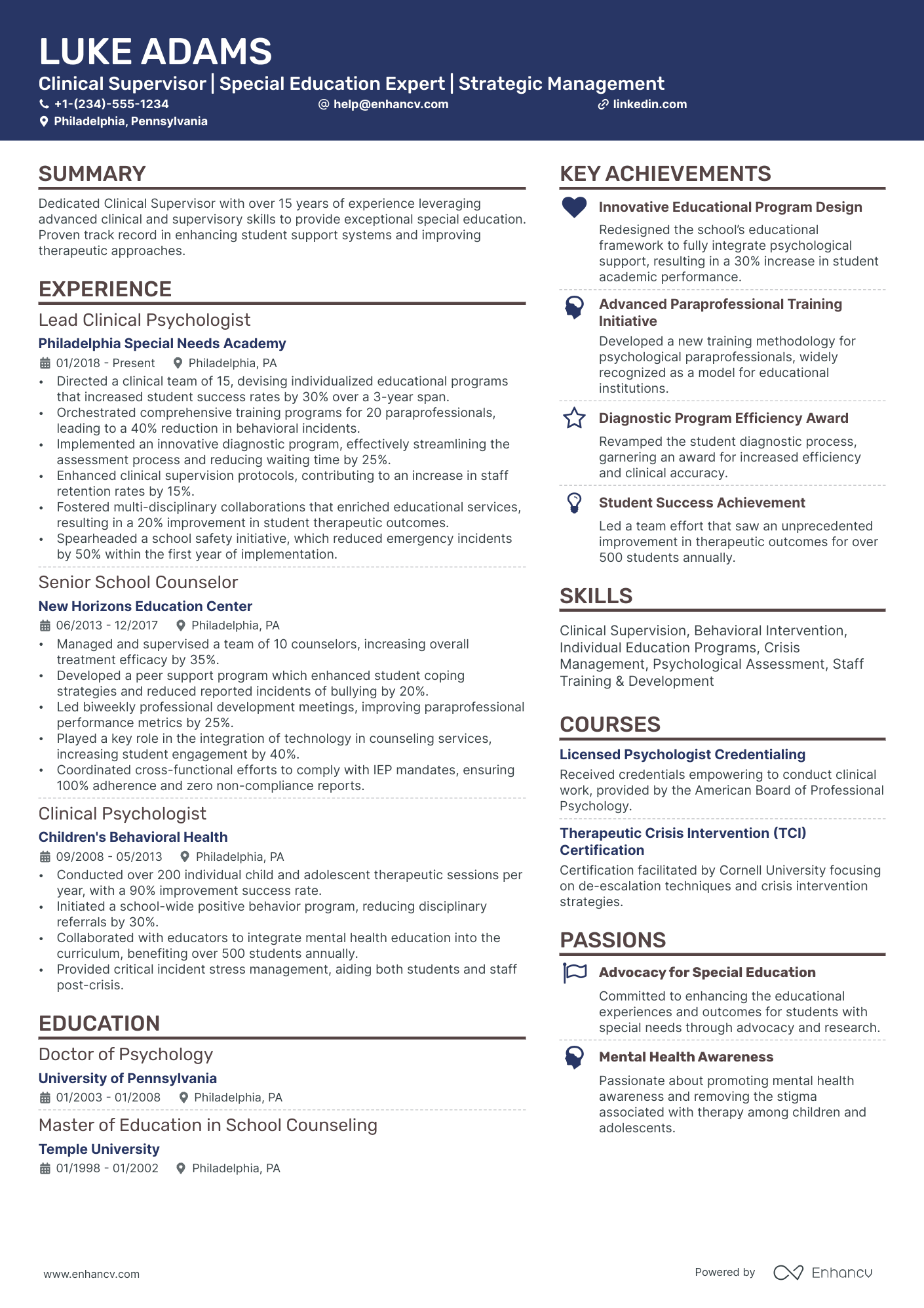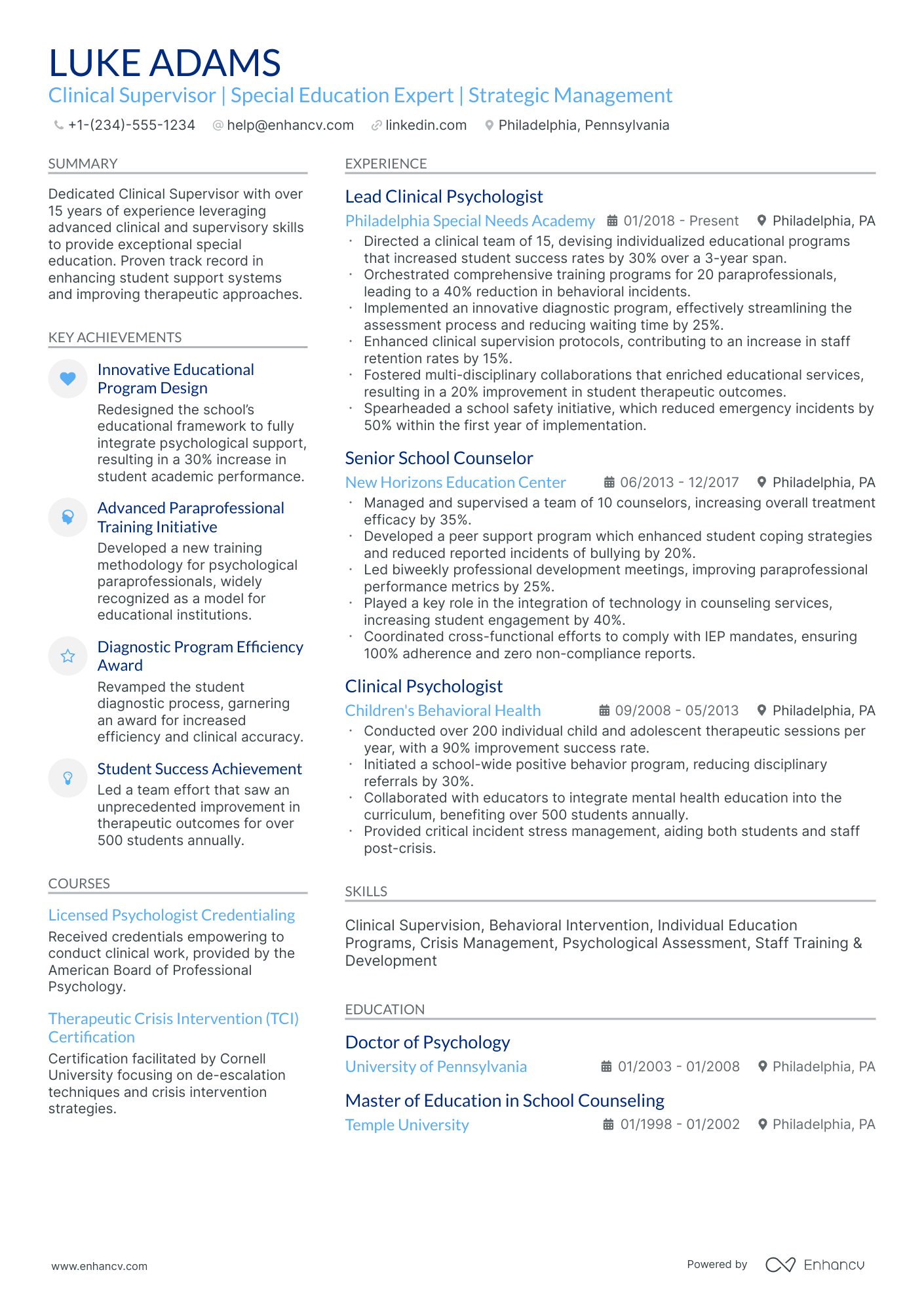Crafting a resume that effectively showcases your extensive leadership experience and clinical expertise is a common challenge for any clinical director. Our guide provides tailored strategies to highlight your proficiency in managing healthcare teams and improving patient outcomes, ensuring you present a compelling narrative to potential employers.
- The most straightforward and effective resume format, ensuring your clinical director resume stands out among numerous candidate profiles;
- The significance of the top one-third of your resume, including the header, summary or objective, and skills section, and its impact on recruiters;
- Frameworks and structures used by real clinical director professionals, offering insights on how to enhance your resume with industry-specific expertise;
- A variety of clinical director resume sections that bolster your profile, showcasing your comprehensive capabilities and distinctiveness.
Gaining insights from the best has never been easier. Explore more clinical director resume examples below:
- Company Nurse Resume Example
- Physician Assistant Resume Example
- Hemodialysis Nurse Resume Example
- Pediatric Dental Assistant Resume Example
- LVN Resume Example
- Occupational Health Nurse Resume Example
- Pharmacy Manager Resume Example
- Public Health Resume Example
- Surgical Tech Resume Example
- Speech Pathologist Resume Example
Optimize your clinical director resume format to pass the recruiters' assessment
You may be wondering just how much time you need to spend on designing your clinical director resume.
What recruiters are looking for is systematised content that is clear and coherent. Thus, your clinical director resume needs to answer requirements and why you're the best candidate for the role from the get-go.
Often, a clear layout consists of:
- Sorting your experience in the reverse chronological order - starting with your most recent and relevant roles. This is an excellent choice for more experienced professionals;
- Writing your contact information (e.g. personal phone number and email address) and your portfolio or LinkedIn link in your clinical director resume header. If you're wondering to include a photo or not, always make sure that it's appropriate for the country you're applying in;
- Use the basic, most important clinical director resume sections - your experience, education, summary, etc. Use your resume's real estate wisely to tell a compelling, professional story and match job description's keywords;
- Don't go overboard with the length of your resume. One page is absolutely fine if you happen to have under a decade of relevant experience.
Are you still wondering if you should submit your clinical director resume in PDF or Word format ? The PDF has a few more advantages, as it doesn't change the format and the text can't be altered upon application.
Format matters most when your clinical director resume is assessed by the Applicant Tracker System (or the ATS).
The ATS parses resumes, looking for specific keywords, skills or experience that match the job description.
P.S. We recently did a study on how the ATS works and were able to demystify three of the biggest misconceptions about how it assesses candidate resumes.
To pass the ATS evaluation, select any of the serif or sans-serif fonts. Popular choices that would help your clinical director resume stand out include Raleway, Exo 2, Montserrat, etc.
Most traditionalists go for Arial or Times New Roman, but it's often the case that many candidates choose these fonts, and you'd thus lose points on the uniqueness front.
Targeting Canada? – Keep in mind their resume layout may differ from others.
Upload & Check Your Resume
Drop your resume here or choose a file. PDF & DOCX only. Max 2MB file size.
PRO TIP
If the certificate you've obtained is especially vital for the industry or company, include it as part of your name within the resume headline.
The five (plus) definite sections your resume for a clinical director job should include are:
- Header with your headline, contact details, and/or a preview of your work
- Summary (or objective) to pinpoint how your success aligns with the role
- Experience with bullets of your most relevant achievements in the field
- Skills to integrate vital job requirements (both technical and personal)
- Your further dedication to the field, showcased via relevant higher education and/or certifications
What recruiters want to see on your resume:
- Proven experience in clinical program development, implementation, and evaluation
- Demonstrated leadership and team management skills, with the ability to mentor and guide healthcare professionals
- Strong understanding of healthcare regulations, accreditation standards, and quality assurance protocols
- Effective communication and negotiation skills with a track record of fostering interdisciplinary collaboration
- Financial acumen with experience in budgeting, resource allocation, and cost control in a clinical setting
Quick guide to your clinical director resume experience section
After deciding on the format of your resume, it's time to organize your experience within the dedicated section.
It's common for clinical director professionals to be confused in this part of the process, as they may have too much or little expertise.
Follow the general rules of thumb to be successful when writing this part of your resume:
- The perfect number of bullets you should have under each experience item is no more than six;
- Select not merely your responsibilities, but the most noteworthy achievements for each role that match the job requirements;
- List any certificates or technical expertise you've gained on the job and how they've helped you progress as a professional;
- Carefully select the power verbs to go along with each bullet to avoid generic ones like "managed" and instead substitute those with the actuality of your particular responsibility;
- Integrate valuable keywords from the job advert in the form of achievements under each role you list.
If you're on the search for further advice on how to write your clinical director experience section, get some ideas from real-world professional resumes:
- Directed a multidisciplinary team of 50+ staff at a leading mental health clinic, overseeing patient care programs and improving treatment protocols, which enhanced patient satisfaction by 30%.
- Implemented an innovative evidence-based practice program that increased the clinic's treatment efficacy by 25%, significantly improving patient outcomes and reducing readmission rates.
- Secured $1 million in federal grants for clinic service expansion by crafting compelling proposals and demonstrating a track-record of successful healthcare management.
- Led the integration of mental health services with primary care at a community health center, fostering a holistic care model and amplifying patient reach by 40%.
- Managed a budget of $5 million, achieving a 15% cost reduction through strategic negotiations with suppliers and streamlining of administrative processes.
- Championed the development and launch of an outpatient substance abuse program that served 200+ patients in its first year, substantially enhancing the center's portfolio of services.
- Developed and executed a comprehensive quality improvement plan that increased overall clinical service quality by 20%, as measured by internal and external audit scores.
- Managed relationships with key stakeholders, including insurance providers and healthcare networks, broadening the clinic’s affiliations and boosting patient volumes by 25%.
- Coordinated clinical research initiatives in partnership with local universities that contributed to the development of two patented therapeutic techniques.
- Oversee the strategic planning and operation of clinical programs in a high-volume hospital setting, serving 10,000+ patients annually with a focus on continuous improvement.
- Spearheaded the transition to a digital health records system, enhancing data accuracy and staff efficiency, while maintaining a 99.9% patient privacy compliance rate.
- Implemented staff development initiatives that resulted in a 90% employee retention rate and increased staff satisfaction by enhancing the clinic’s reputation as an employer of choice.
- Pioneered a telemedicine program that successfully delivered virtual healthcare services to over 3,000 patients in remote areas, significantly increasing the clinic’s market share.
- Orchestrated a collaborative agreement with pharmaceutical companies to participate in cutting-edge medication trials, elevating the clinic’s profile in innovative treatment approaches.
- Generated a 35% improvement in patient flow efficiency through the redesign of clinic layouts and scheduling systems.
- Managed clinical operations for a network of five outpatient clinics, standardizing protocols across sites and achieving a 20% increase in organizational efficiency.
- Established a comprehensive staff training program that upskilled 100+ healthcare professionals in the latest treatment methodologies and technology applications.
- Instrumental in leading the clinic’s accreditation process, resulting in the attainment of the prestigious Joint Commission Gold Seal of Approval.
- Cultivated a center of excellence program for specialized patient care, attracting top talent and industry recognition, leading to a 50% increase in specialty procedure volume.
- Launched a proactive mental health outreach initiative that served over 500 at-risk community members annually, decreasing acute incidents and ER visits by 20%.
- Negotiated with insurance providers to expand covered services, adding 6 new therapies to the clinic’s offerings and improving patient access to comprehensive care.
- Directed a holistic care initiative that integrated physical, mental, and social health services, delivering an all-inclusive care model that increased patient satisfaction ratings to 95%.
- Strategically expanded the clinical team by 25%, adding specialized roles that addressed critical healthcare gaps and improved service delivery efficiency.
- Led a cross-functional team in a successful EHR system implementation that reduced administrative time by 30%, allowing clinicians to spend more time on patient care.
The following content includes information from "O*NET OnLine" by the U.S. Department of Labor, Employment and Training Administration (USDOL/ETA). Used under the CC BY 4.0 license. The data represents the top responsibilities present on the task lists for clinical director professionals.
Top Responsibilities for Clinical Director:
- Direct, supervise and evaluate work activities of medical, nursing, technical, clerical, service, maintenance, and other personnel.
- Develop and maintain computerized record management systems to store and process data, such as personnel activities and information, and to produce reports.
- Plan, implement, and administer programs and services in a health care or medical facility, including personnel administration, training, and coordination of medical, nursing and physical plant staff.
- Conduct and administer fiscal operations, including accounting, planning budgets, authorizing expenditures, establishing rates for services, and coordinating financial reporting.
- Maintain awareness of advances in medicine, computerized diagnostic and treatment equipment, data processing technology, government regulations, health insurance changes, and financing options.
- Establish work schedules and assignments for staff, according to workload, space, and equipment availability.
- Monitor the use of diagnostic services, inpatient beds, facilities, and staff to ensure effective use of resources and assess the need for additional staff, equipment, and services.
- Direct or conduct recruitment, hiring, and training of personnel.
- Manage change in integrated health care delivery systems, such as work restructuring, technological innovations, and shifts in the focus of care.
- Maintain communication between governing boards, medical staff, and department heads by attending board meetings and coordinating interdepartmental functioning.
Quantifying impact on your resume
- Mention the total operational budget you've successfully managed to illustrate financial stewardship.
- Highlight specific percentage reductions in patient readmission rates to showcase quality improvement initiatives.
- Include figures that demonstrate the growth of patient volumes under your leadership to indicate strategic planning success.
- State the number of clinical programs you've developed or expanded to reflect innovation and service enhancement.
- Quantify the scale of interdisciplinary teams you've led to showcase leadership and team-building skills.
- Detail any increase in patient satisfaction scores to highlight your commitment to patient-centered care.
- List the total number of staff you've recruited or trained to demonstrate human resource management capabilities.
- Specify the percentage decrease in operational costs you've achieved through efficiency improvements.
Action verbs for your clinical director resume
Remember these four tips when writing your clinical director resume with no experience
You've done the work - auditing the job requirements for keywords and have a pretty good idea of the skill set the ideal candidate must possess.
Yet, your professional experience amounts to a summer internship .
Even if you have limited or no professional expertise that matches the role you're applying for, you can use the resume experience section to:
- List extracurricular activities that are relevant to the job requirements. Let's say you were editor-in-chief of your college newspaper or part of the engineering society. Both activities have taught you invaluable, transferrable skills (e.g. communication or leadership) that can be crucial for the job;
- Substitute jobs with volunteer experience. Participating in charity projects has probably helped you develop an array of soft skills (e.g. meeting deadlines and interpersonal communications). On the other hand, volunteering shows potential employers more about you: who you are and what are the causes you care about;
- Align job applications with your projects. Even your final-year thesis work could be seen as relevant experience, if it's in the same industry as the job you're applying for. Ensure you've listed the key skills your project has taught you, alongside tangible outcomes or your project success;
- Shift the focus to your transferrable skills. We've said it before, but recruiters will assess your profile upon both job requirements and the skills you possess. Consider what your current experience - both academic and life - has taught you and how you've been able to develop your talents.
Recommended reads:
PRO TIP
Bold the names of educational institutions and certifying bodies for emphasis.
Shining a light on your clinical director hard skills and soft skills
To win recruiters over, you must really have a breadth of skill set presented and supported within your clinical director resume.
On hiring managers' checklists, you'd initially discover hard or technical skills. Those are the technology (and software) that help you perform on the job. Hard skills are easy to quantify via your education, certificates, and on-the-job success.
Another main criterion recruiters are always assessing your clinical director resume on is soft skills. That is your ability to communicate, adapt, and grow in new environments. Soft skills are a bit harder to measure, as they are gained both thanks to your personal and professional experience.
Showcase you have the ideal skill set for the role by:
- Dedicating both a skills box (for your technical capabilities) and an achievements or strengths section (to detail your personal skills).
- When listing your skills, be specific about your hard skills (name the precise technology you're able to use) and soft skills (aim to always demonstrate what the outcomes were).
- Avoid listing overused cliches in the skills section (e.g. Microsoft Office and Communication), unless they're otherwise specified as prominent for the role.
- Select up to ten skills which should be defined via various sections in your resume skills sidebar (e.g. a technical skills box, industry expertise box with sliders, strengths section with bullets).
Spice up your resume with leading technical and people skills, that'd help you get noticed by recruiters.
Top skills for your clinical director resume:
Electronic Health Records (EHR) Systems
Clinical Data Management Software
Clinical Trial Management Systems (CTMS)
Telemedicine Platforms
Regulatory Compliance Tools
Patient Management Systems
Billing and Coding Software
Data Analysis Tools (e.g., SPSS, R)
Medical Imaging Software
Quality Improvement Tools
Leadership
Communication
Conflict Resolution
Team Building
Critical Thinking
Problem Solving
Empathy
Time Management
Decision Making
Adaptability
Next, you will find information on the top technologies for clinical director professonals from "O*NET OnLine" by the U.S. Department of Labor, Employment and Training Administration (USDOL/ETA). Used under the CC BY 4.0 license.
Top technologies for Clinical Director’s resume:
- eClinicalWorks EHR software
- Henry Schein Dentrix
- Blackboard software
- Yardi software
- IBM SPSS Statistics
- SAS
PRO TIP
Showcase any ongoing or recent educational efforts to stay updated in your field.
How to include your education and certifications on your resume
We're taking you back to your college days with this part of our guide, but including your relevant higher education is quite important for your resume.
Your degree shows recruiters your dedication to the industry, your recent and relevant know-how, and some form of experience in the field.
Your clinical director resume education should:
- Include your applicable degrees, college (-s) you've graduated from, as well as start and end dates of your higher education;
- Skip your high school diploma. If you still haven't graduated with your degree, list that your higher education isongoing;
- Feature any postgraduate diplomas in your resume header or summary - this is the perfect space to spotlight your relevant MBA degree;
- Showcase any relevant coursework, if you happen to have less professional experience and think this would support your case in being the best candidate for the role.
As far as your job-specific certificates are concerned - choose up to several of the most recent ones that match the job profile, and include them in a dedicated section.
We've saved you some time by selecting the most prominent industry certificates below.
The top 5 certifications for your clinical director resume:
- Board Certification in Healthcare Management (FACHE) – American College of Healthcare Executives
- Certified Medical Manager (CMM) – Professional Association of Health Care Office Management
- Certified Healthcare Financial Professional (CHFP) – Healthcare Financial Management Association
- Certified Professional in Healthcare Quality (CPHQ) – National Association for Healthcare Quality
- Certified Physician Practice Manager (CPPM) – American Academy of Professional Coders
The content below includes information from "O*NET OnLine" by the U.S. Department of Labor, Employment and Training Administration (USDOL/ETA). Used under the CC BY 4.0 license. The data represents the top associations for clinical director professionals.
Top US associations for a Clinical Director professional
- Academy of Nutrition and Dietetics
- American College of Health Care Administrators
- American College of Healthcare Executives
- American Health Information Management Association
- American Nurses Association
PRO TIP
The more time and effort you've put into obtaining the relevant certificate, the closer to the top it should be listed. This is especially important for more senior roles and if the company you're applying for is more forward-facing.
Recommended reads:
Clinical director resume summary or objective? the best choice is based on your experience
If you're wondering about the relevancy of the resume summary or the resume objective to your clinical director application - here's the truth.
The summary and objective provide recruiters with your expertise and accomplishments at a glance, within an up-to-five-sentence structure.
The difference is that the:
- Resume objective is also more focused on emphasizing your career goals. The objective is the perfect fit for (potentially more junior) candidates who'd like to balance their relevant experience with their career goals.
- Resume summary can provide you with space to also detail the unique value of what it's like to work with you. Clinical director candidates who have many noteworthy accomplishments start from the get-go with their summary.
Ensure that either type of resume introduction presents your clinical director expertise in the best light and aligns it with the job advert.
The more details you can provide with numbers, the more compelling your resume summary or objective will be.
Real-world clinical director candidates follow these frameworks in writing their resume summaries and objectives.
The end results are usually as such:
Resume summaries for a clinical director job
- With a robust 10-year track record as an Oncology clinical director, I have led groundbreaking trials that resulted in a 20% patient survival rate increase. My expertise lies in strategic planning and implementing cutting-edge treatment protocols, all while managing a team of over 50 healthcare professionals in a high-pressure environment.
- Dedicated clinical director with 15 years of experience in Pediatric care, I successfully expanded the department by 40% through strategic collaborations and quality improvements. My leadership is marked by the ability to foster a collaborative culture, ensuring high patient satisfaction and adherence to the most current standards of pediatric care.
- A Senior Financial Analyst transitioning to a clinical director role, bringing a decade of experience in budgeting and financial forecasting to guide fiscal management in clinical settings. My analytical skills combined with a deep understanding of healthcare economics will contribute to efficient resource allocation and operational excellence.
- As an experienced IT Project Manager endeavoring to pivot into clinical management, I bring a 12-year tenure of leading complex projects to fruition. My adeptness in process optimization and team leadership is poised to drive improvements in clinical operations, backed by a passion for adopting technology to enhance patient care.
- Eager to apply my extensive background in academic research and volunteer patient advocacy to a clinical director's responsibilities, my goal is to contribute fresh insights into patient care management. I am committed to learning from seasoned professionals and dedicating myself to advancing clinical practices through evidence-based decision-making.
- Transitioning from a successful career in pharmaceutical sales, I aim to leverage my comprehensive understanding of drug development and market dynamics to the management of clinical operations. My objective is to bring a unique perspective to patient care strategies while honing my skills in clinical leadership and administration.
Optimize your resume summary and objective for ATS
Drop your resume here or choose a file.
PDF & DOCX only. Max 2MB file size.
Average salary info by state in the US for clinical director professionals
Local salary info for Clinical Director.” Source: My Next Move, National Center for O*NET Development. Accessed 10/15/2024
| State | Average Salary (in USD) |
|---|---|
| US National Average | $110,680 |
| California (CA) | $139,430 |
| Texas (TX) | $105,460 |
| Florida (FL) | $104,310 |
| New York (NY) | $144,230 |
| Pennsylvania (PA) | $106,270 |
| Illinois (IL) | $109,050 |
| Ohio (OH) | $103,690 |
| Georgia (GA) | $128,660 |
| North Carolina (NC) | $105,640 |
| Michigan (MI) | $101,840 |
Recruiters' favorite additional clinical director resume sections
When writing your clinical director resume, you may be thinking to yourself, " Is there anything more I can add on to stand out? ".
Include any of the below four sections you deem relevant, to ensure your clinical director resume further builds up your professional and personal profile:
Key takeaways
- The layout of your resume should take into consideration your professional background while integrating vital sections and design elements;
- Highlight your most pertinent achievements for the role all through different sections;
- Be very specific when selecting your certifications, hard skills, and soft skills to showcase the best of your talents;
- Include within the top one-third of your clinical director resume a header and summary to help recruiters understand your experience and allocate your contact details. A skills box is optional, but it will help you align your expertise with the role;
- Detail the full extent of your professional experience with specific bullets that focus on tasks, actions, and outcomes.
